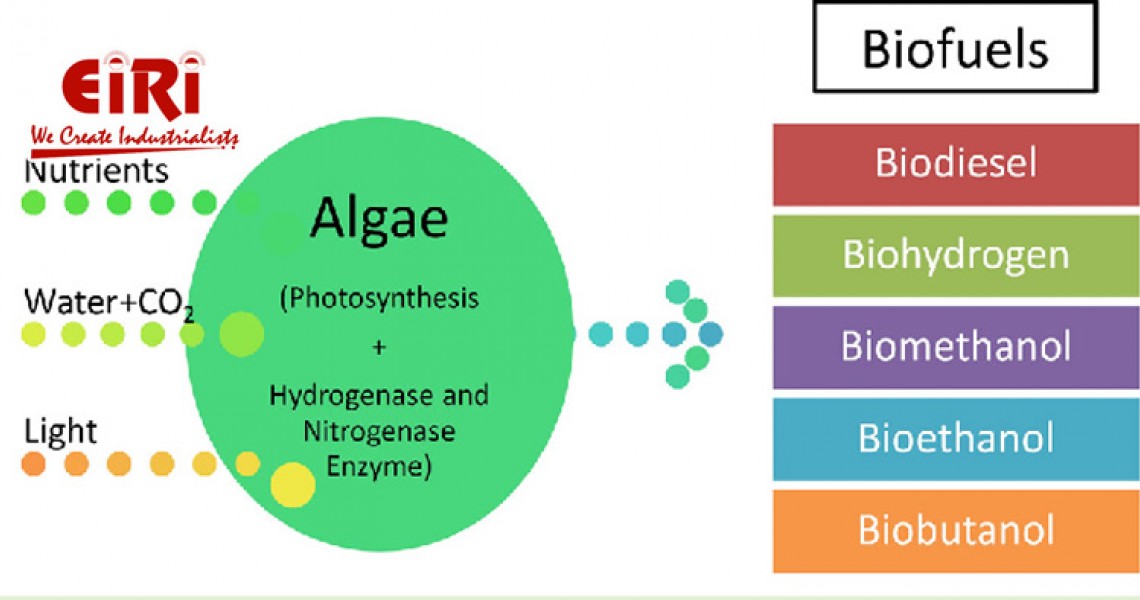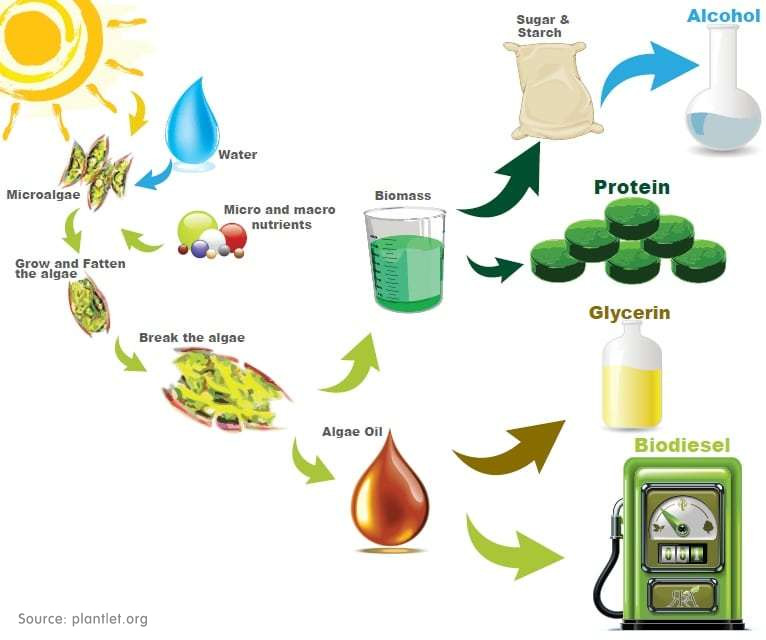Biofuel from Algae: The Journey to Sustainable Biofuel

Algae biofuel, a renewable energy source derived from various types of algae, harnesses the photosynthetic abilities of these simple organisms to convert sunlight into energy. Under specific conditions, algae accumulate lipids (oils) that can be extracted and processed into biofuels. This eco-friendly fuel option holds promise due to its ability to produce high biomass yields and its versatility in cultivation, thriving in environments like non-arable land and wastewater.
In the quest for sustainable energy sources, scientists and researchers have turned their attention to the vast potential of algae as a biofuel feedstock. Algae, microscopic aquatic organisms, offer a promising alternative to conventional fossil fuels due to their rapid growth rate, high lipid content, and minimal environmental impact. This article explores the fascinating world of algae-based biofuels, highlighting their production process, environmental benefits, and challenges.
The market for algae biofuels has experienced notable growth, fueled by mounting concerns about climate change, the imperative for sustainable energy solutions, and a concerted effort to curb greenhouse gas emissions. Algae biofuels offer distinct advantages over conventional counterparts derived from crops like corn or soybeans, boasting higher productivity per unit of land, reduced competition for arable land and freshwater resources, and adaptability to diverse climates. Ongoing research and development endeavors aim to enhance algae strains for increased lipid content, refine cultivation methods, and devise cost-effective harvesting and extraction techniques. With continued advancements, algae biofuels are positioned to make a substantial impact on the global transition to cleaner and more sustainable energy sources.
The Algae Advantage:
Algae possess several inherent advantages that make them an attractive candidate for biofuel production. Unlike traditional energy crops such as corn or sugarcane, algae can be cultivated in a wide range of environments, including ponds, bioreactors, and even wastewater treatment plants. Their ability to thrive in diverse conditions makes algae cultivation less land-intensive and reduces competition with food crops for arable land.
Furthermore, algae exhibit rapid growth rates and can double their biomass within hours under optimal conditions. This rapid growth, coupled with their high lipid content, makes algae one of the most efficient sources of biomass for biofuel production. These lipids, or oils, can be extracted and converted into biodiesel through a process known as transesterification, offering a renewable and sustainable alternative to traditional petroleum-based diesel fuel.
Environmental Benefits:
One of the primary attractions of algae-based biofuels is their potential to mitigate greenhouse gas emissions and reduce dependence on fossil fuels. Unlike fossil fuels, which release carbon dioxide stored underground into the atmosphere when burned, algae-based biofuels utilize CO2 from the atmosphere during their growth phase. This carbon-neutral cycle helps to offset carbon emissions and combat climate change.
Moreover, algae cultivation can be integrated with other industrial processes to enhance sustainability. For example, algae can be grown in wastewater treatment plants to remove nutrients and pollutants from wastewater while simultaneously producing biomass for biofuel production. This symbiotic relationship between algae cultivation and wastewater treatment helps to mitigate environmental pollution and promote resource efficiency.
Market Overview and Growth Drivers
In 2022, the global algae biofuel market reached USD 8.38 billion and is forecasted to grow at a CAGR of 10.1% from 2023 to 2030.
The algae biofuel market is experiencing significant growth due to the increasing demand for bio-based resources as replacements for traditional fossil fuels. This demand is driven by global concerns about climate change and the need for sustainable energy alternatives. Algae's remarkable ability to produce various biofuels, including bioethanol, biodiesel, drop-in biofuels, and hydrocarbons, has garnered attention from manufacturers seeking to capitalize on its potential. Despite facing challenges over the past decade and experiencing setbacks from decommissioned commercial projects, the industry remains optimistic about its prospects. Overcoming barriers related to raw material manufacturing, capital costs, and production volumes is crucial for unleashing the full potential of algae biofuels.
The algae biofuel market is propelled by the aviation industry's increasing demand for low-cost fuels, driving the market growth rate upward. As the aviation sector seeks sustainable alternatives to traditional jet fuels, algae biofuels offer a promising solution. Additionally, the expansion of end-use industries, coupled with efforts to meet international goals for carbon neutrality, further drives demand for algae biofuels. Continuous research and development efforts are focused on finding cost-effective and environmentally friendly fuel alternatives. With ongoing advancements in technology and industrial processes, algae biofuel production is becoming increasingly economically viable, positioning it as a key player in the global transition to cleaner energy sources.
As the world searches for greener, renewable alternatives to traditional biofuels, algae biofuels emerge as a promising third-generation option. Unlike second-generation biofuels derived from crops, algae biofuels offer several advantages, including higher yields, quicker microbial development, and greater biodegradability. Various algae species, such as Chlorella and Crypthecodinium cohnii, are utilized in biofuel production, supported by contemporary biochemical engineering techniques. Ongoing research and industrial efforts are paving the way for the commercialization of algae biofuels, making them increasingly viable both economically and environmentally. With the global focus on sustainability and reducing greenhouse gas emissions, algae biofuels are poised to play a significant role in meeting future energy needs.
The Production Process:
The production of algae-based biofuels typically involves several key steps, beginning with the cultivation of algae in large-scale ponds or closed-loop photobioreactors. Algae cultivation requires nutrients such as nitrogen, phosphorus, and potassium, as well as carbon dioxide (CO2) and sunlight for photosynthesis. In open pond systems, algae are grown in shallow ponds or raceways, where they absorb CO2 from the atmosphere and convert it into biomass through photosynthesis.
Once the algae reach a sufficient biomass density, they are harvested and processed to extract the lipid-rich oils. This extraction process can vary depending on the algae species and the desired end product but often involves mechanical pressing or solvent extraction methods. The extracted oils are then refined and converted into biodiesel through transesterification, a chemical process that breaks down the oils into fatty acid methyl esters (FAME), which can be used as a drop-in replacement for petroleum diesel in existing diesel engines.

- Cultivation of Algae: Algae cultivation involves growing algae in large-scale ponds or closed-loop photobioreactors. These algae require essential nutrients like nitrogen, phosphorus, and potassium, along with carbon dioxide (CO2) and sunlight for photosynthesis. Open pond systems utilize shallow ponds or raceways for algae growth, where they absorb CO2 from the atmosphere and convert it into biomass through photosynthesis.
- Harvesting: Once the algae reach a certain biomass density, they are harvested. The harvesting process involves collecting the algae from the cultivation system. The harvested algae are then processed to extract the lipid-rich oils, which are the primary source of biofuel. The extraction methods can vary, including mechanical pressing or solvent extraction, depending on the algae species and desired end product.
- Oil Extraction: After harvesting, the algae undergo oil extraction to obtain the lipid-rich oils. This extraction process typically involves mechanical pressing or solvent extraction methods. Mechanical pressing physically separates the oils from the algae biomass, while solvent extraction utilizes solvents to dissolve the oils, which are then separated from the solvent.
- Refinement and Conversion: The extracted oils undergo refinement to remove impurities and unwanted components. Subsequently, the refined oils are converted into biodiesel through a process called transesterification. This chemical process breaks down the oils into fatty acid methyl esters (FAME), which can be used as a drop-in replacement for petroleum diesel in existing diesel engines.
Challenges and Future Outlook:
Despite their immense potential, algae-based biofuels face several challenges that must be addressed to realize widespread commercialization. These challenges include the high cost of algae cultivation, the energy-intensive nature of algae harvesting and processing, and the need for large-scale infrastructure for biofuel production and distribution. Additionally, competition with low-cost petroleum fuels and other renewable energy sources presents a barrier to market penetration.
However, ongoing research and development efforts are focused on overcoming these challenges and improving the efficiency and scalability of algae-based biofuel production. Advances in biotechnology, genetic engineering, and cultivation techniques hold promise for enhancing algae productivity, increasing lipid yields, and reducing production costs. Furthermore, strategic partnerships between government agencies, academic institutions, and private sector companies are driving innovation and accelerating the commercialization of algae-based biofuels.
In conclusion, algae-based biofuels represent a promising pathway towards a more sustainable and environmentally friendly energy future. By harnessing the power of algae, we can reduce our reliance on fossil fuels, mitigate climate change, and promote economic development. With continued investment and innovation, algae-based biofuels have the potential to revolutionize the energy landscape and pave the way towards a cleaner, greener future.










